Around the traps
With the monthly dollar value of investment loans having more than doubled since the beginning of 2012, the regulator APRA has become obliged to take action in order to cool the investor segment of the Australian property market.
In the first seven months of this calendar year, the volume of investment lending had continued to burn higher everywhere except for the resources regions of Western Australia and the Northern Territory, thereby forcing the hand of the regulator to dial back demand.

And as expected, the July figures showed that APRA's cooling measures are now working.
In seasonally adjusted terms, total investment lending has ticked back from $14.1 billion to $13.6 billion in July since peaking in April.
Let's take a look at where APRA's crackdown has taken and will take the most effect.
New South Wales
One of the challenges facing macroprudential controls on investor lending is that booming real estate markets create deep pools of equity for existing owners to redeploy, as regulators in New Zealand are discovering in relation to the overheating Auckland property market.
Given that Sydney dwelling prices have blazed nearly 80 percent higher since the end of 2008, a similar dynamic exists in the harbour city too.
Until the second quarter of 2013, it was unheard of in Australia for investment loans to print materially above $3 billion at the state level in any given month.
Since that time, the Sydney investor cohort has been accelerating its activity maniacally, to the extent that in March of this year, more than $6 billion of NSW originated investment loans were written in a single month. The market has since repeated the trick in a further three of the last four months.
However, what we can say is that investor lending of $6 billion in July was some way below the record high $6.5 billion seen in June, suggesting that APRA's measures are gradually having the desired effect.
In turn, we should see auction clearance rates now declining, particularly in those "high density" property markets that have been overwhelmingly dominated by investors.
Despite this, NSW continued to account for more than 45 per cent of all investor lending nationally and on a 12mMA basis investor lending has ripped from $4.2 billion to $5.5 billion over the past year.
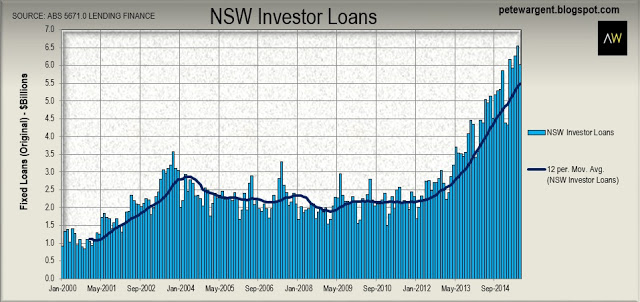
Offsetting this slowdown in investor lending, NSW owner-occupier loans have picked up the slack blazing to an unprecedented $7.5 billion in July to be up by 28 percent over the year. It therefore seems likely that it will take a normalisation of lending rates to stop yet further price gains in the rampant Sydney market.
Victoria
Investment loans in original terms in Victoria also ticked back from $3.6 billion to $3.3 billion in July, although the trend has been driving higher over the past year with the moving average rising from $2.7 billion to $3 billion.
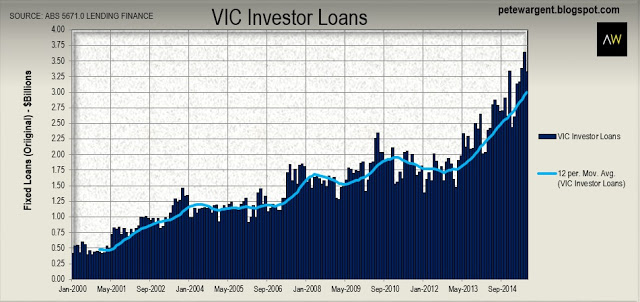
There is, however, an exceptionally high volume of dwelling construction in the pipeline in Victoria, which should absorb investor loans and dampen rents and price growth in due course.
Queensland
Investor lending in Queensland has been undergoing a long, drawn out recovery since punching out some exuberant monthly numbers in 2007.
The July result of $1.81 billion in original terms was down from $1.94 billion in June, but on a 12mMA basis, investor lending originated in Queensland has now hit its highest level since April 2008.
Note that these are dollar values (as opposed to number of loans written), which we should expect to see rising over time due to inflation and a steadily growing volume of rental stock.
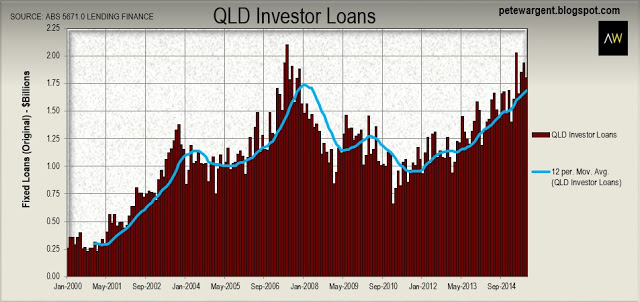
The Queensland economy is something of a dichotomy comprising a punishing resources investment bust, but also a currency-driven resurgence in tourism, which should theoretically benefit a couple of the key coastal regions.
There is also some evidence of interstate investor interest in Queensland property.
Western Australia
Investment loans in Western Australia ticked down to $1.1 billion in July, having peaked all the way back in June 2014, with the trendline for investment lending in dollar terms also peaking back in March of this year.

The Western Australian economy is also facing the fallout of a rapid decline in resources investment.
South Australia
A challenge facing the southern states is that since capital growth has been so lacklustre, there has been comparatively little equity created in the market since 2007.
With confidence waning investment lending fell by more than 20 percent in original terms in July and the trendline has also now slipped lower accordingly, with South Australia now accounting for just 3 per cent of investment lending nationally.
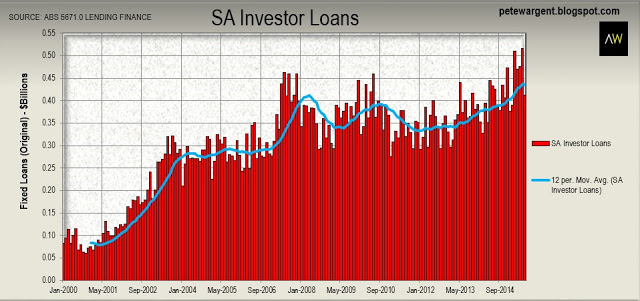
It rarely pays to get too excited about one month of data, but the labour market fundamentals in South Australia have been exceptionally weak, with no full time jobs created on a net basis since 2007 and the trend unemployment rate spiking from 6.6 percent to 8.1 percent in less than 12 months. Dwelling prices can escape their underlying fundamentals for a time, of course, and may even rise in tandem with deteriorating unemployment rates and an employment shock.
Indeed, CoreLogic-RP Data reports that Adelaide's median home value has increased by 0.75 per cent over the past year - but ultimately price and fundamentals do remain linked, even if only by a "mile long rubber band."
Tasmania
Tasmania has also experienced flat housing markets for most of the past decade, yet without material population growth to contend with, the unemployment rate has instead been trending down.
As another state economy which stands to benefit from the sharp depreciation in the Australian dollar, Tasmania could be the surprise package housing market for the next couple of years, and there has been a commensurate run-up in investment lending over the preceding 24 months.
That said, the APRA effect evidently had a direct impact in the Apple-Isle too, with a record high month of investor lending in June immediately reversed in July.
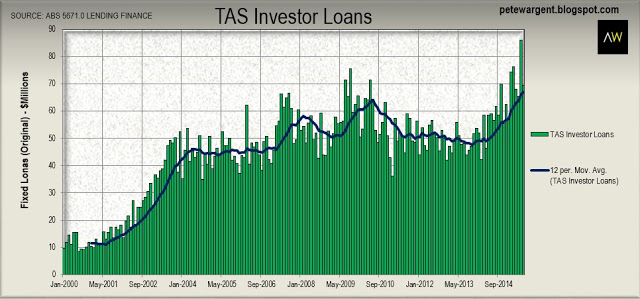
Australian Capital Territory (ACT)
A very similar exists in dynamic in the ACT, with investor lending pulling back from $217 million in June to $200 million in July, although the trendline has been rising since September 2014, partly in response to interest rate moves.
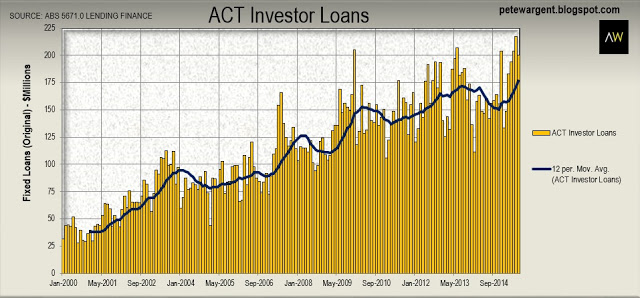
The Northern Territory
Finally investment lending in the volatile Northern Territory has now been trending down for 10 months following a stellar run since 2011, and may now be set to decline sharply following the downturn in commodity prices and resources investment.
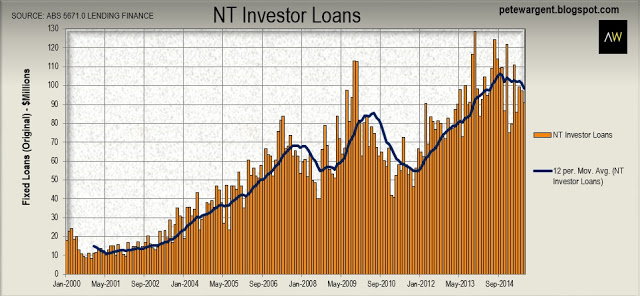
The wrap
Investor lending over the first seven months of the year has been tracking dramatically higher than in 2014 in all states and territories except for Western Australia and the Northern Territory.
However, APRA's measures had noticeably begun to take effect almost right across the board by July suggesting that investor lending in aggregate likely peaked for this cycle in April 2015.
Although Westpac sees APRA's regulatory intervention as a "temporary disruption" to investor lending, the truth is that there have been too many investors in many housing sub-markets over the past year and this will lead to a surfeit of rental properties, rising vacancy rates, and declining rents in some locations.
This in turn will naturally dampen demand for investor loans over time.
The best performing housing markets will therefore be those where there is robust or pent up demand from owner-occupiers to pick up the slack.
Those higher density investment property types, which have only been in high demand from domestic investors, may slow or correct in due course, ongoing demand from offshore notwithstanding.
